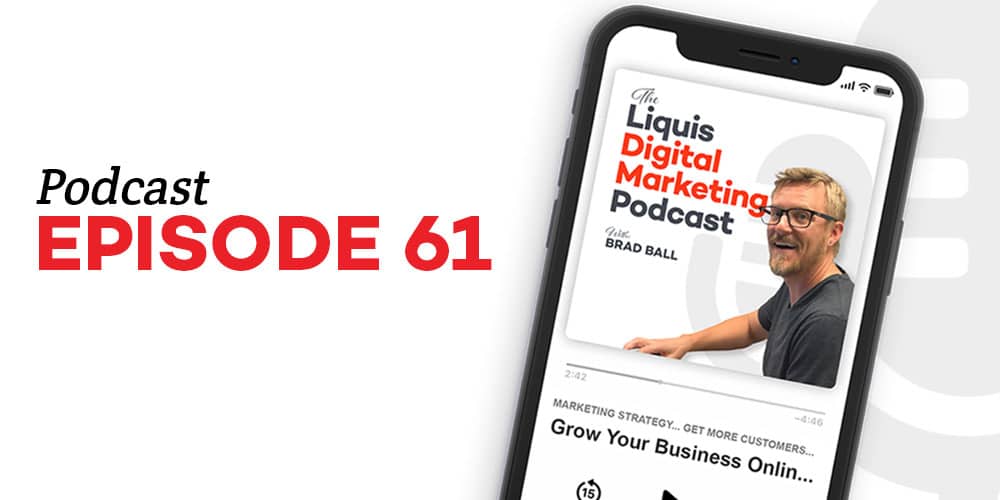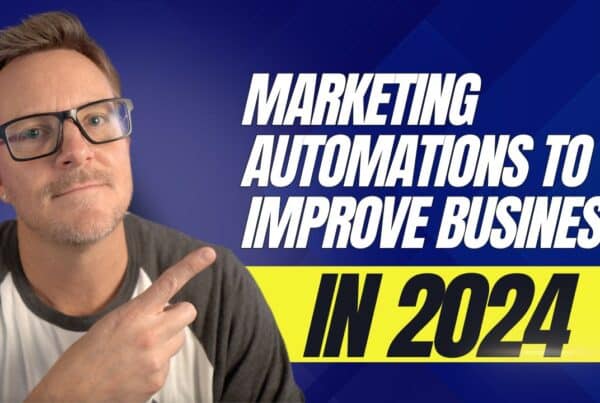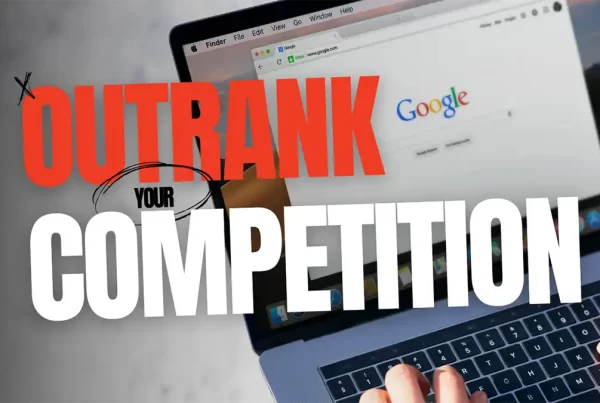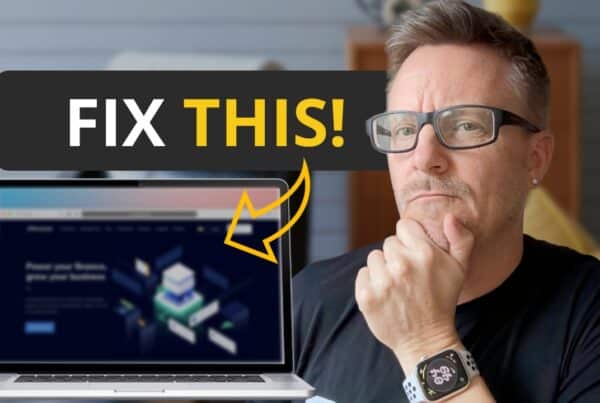Show Notes
A website without the right content is useless, regardless of how well designed it is.
The purpose of your website should be to achieve a measurable result, and it is the content’s job to drive the visitor toward your goal. The design and functionality of the website simply supports the content and enhances the visitor’s experience.
So, how is your content working? Is it working for, or against you?
In this episode, I’ll be walking you though how to create killer website content that converts.
Discussion Topics:
- The importance of website content
- Knowing your objectives
- Knowing your audience
- Knowing your call to action
- And content considerations for your website pages
Resources:
The Lead Generation Website Checklist: https://liquisdigital.com/resources/lead-gen-checklist/
The Website Makeover Toolkit: https://liquisdigital.com/makeover-toolkit/
Episode 61 Transcription:
Creating killer website content that converts.
[00:00:00] A website without the right content is useless, regardless of how well designed it is, the purpose of your website should be to achieve a measurable result. And it’s the content job to drive the visitor toward your goal. The design and functionality of the website is there to support the content and enhance the visitor’s experience.
[00:00:23] So is the content on your website working for you or against you. In this episode, I’m walking you through how you can create killer website content that converts
[00:00:37] welcome to the Liquis digital marketing podcast, where each week we’ll be breaking down complex marketing topics into bite size steps. You can take now to grow a profitable audience for your business. We’ll discuss organic reach, offer optimization, paid advertising, email marketing, content creation, promotion techniques, and so much more.
[00:00:57] I’m your host, Brad Ball, founder of Liquis Digital, a marketing agency that has helped hundreds of clients of every shape and size reach their business goals since 2008. Thanks for joining us today and be sure to subscribe because you won’t wanna miss a beat. Now let’s grow.
[00:01:15] Hello and welcome back to another episode of the Liquis digital marketing podcast. This is episode 61. And we are talking about creating killer content for your website, that converts. So as you heard in the intro, the content on your website is what drives a visitor to take action. So a lot of times when people go out to develop their websites or create their websites, they focus.
[00:01:43] A lot on the design. Now, the design is very important and the functionality is very important, but a lot of times the content is an afterthought. So it’s important to know it’s the content that drives the actions, right? So it’s the headlines. It’s, what’s drawing the people in, and then it’s the copy in the call to actions that are driving them to actually take action.
[00:02:06] And for you to. Your objective. So that’s why the content is so important. When we set out to design and develop a website, we start with the content because for us, and for most web designers, the content is the blueprint to your website. It’s kind of like building your house without having a blueprint.
[00:02:28] You can design it all day long, but if it doesn’t enhance the content or support the content, then it doesn’t matter. The content is the most important element on your website. So let’s talk about some other things that you should know when it comes to developing the content for your website. First off you need to identify, what are your main objectives?
[00:02:52] What are the top 1, 2, 3 things. Max, do you want people to do when they come to your website? Like, what is your objective for your website? Now? I know a lot of people it’s to. Just simply build credibility and to be a place for people to come check them out because most of the time their business comes from referrals.
[00:03:13] Well, a lot of times what that referral will do is once they get that information, they will come to your website and check you out and to see, you know, if they wanna continue forward. So maybe that’s your objective. Maybe your objective is to create sales, maybe it’s to build your list. Maybe it’s to sell a book, maybe it’s to get people, to listen to your podcast.
[00:03:35] Like what are the objectives? And maybe it’s a handful of those things. So which ones are the most important? How are you gonna structure that? So go into it. Knowing what your objective is, what is your main objective? What is your secondary objective with your website? The next thing you need to know is your audience, who is your main target audience.
[00:03:58] So a lot of times when we speak with people about building their websites and we’re going through the discovery phase, their audience is everybody, right? So, which is the completely wrong answer. Your website is not everybody. So you should have a target. Person a target audience. So that doesn’t mean you aren’t gonna service everybody.
[00:04:15] That just means you’re, you’re targeting a specific niche. You’re targeting a specific audience. So know your audience. You can do this by creating a customer avatar. So basically what that is going to do, and we’re gonna do a podcast. Um, and a couple episodes here about creating and developing your customer avatar, but just a quick little glimpse into that.
[00:04:36] What that is is basically it’s really honing in on who your customer is like down to the person, not just a general sense, like, oh, they’re women. They live in the United States and they are from the age of 20 to 40, like, no that’s way, way too general. We’re talking like specific, like it’s Jen Walsh and she is 32 years old and has three kids like it has, it’s a person it’s an avatar.
[00:05:05] So that’s knowing your audience create a customer avatar, and that’s gonna help you with your messaging. And again, stay tuned cuz we have another podcast coming up. That’s going to be about that in a couple weeks. Okay. Moving on. The next thing you need to know is what is your call to action, your call to action, or you’ll hear people say your CTA short for call to action.
[00:05:27] What is the thing you want them to do? And you have to be very clear on your call to action. So your call to action should be very specific, not learn more contact us. I mean, that’s okay. But like, if you can get even better, like schedule a free call or set up a meeting or whatever it is, if you can get more specific or download our free ebook or whatever.
[00:05:52] That’s your call to action. What action do you want people to take? Do you want them to call you? Do you want them to fill out a form? Do you want them to come to your location? Do you want them to listen to something or to watch something? So what is that call to action? So you wanna define what that is?
[00:06:08] Write it down, write all of these things down before you start creating your content. Okay. So now let’s break up some content considerations as it pertains to some of. Main types of pages that you would have on your typical website. Now I understand this doesn’t fit everybody, not everyone’s gonna have these pages, but I would say probably 90% of the people out there that have a typical website will have these pages.
[00:06:32] And those pages are the homepage, the about page, a product or service page and your contact page. So let’s kind of talk about the content that you should have on these. Let’s start with the homepage on your homepage. The content considerations, like, so keep in mind, your homepage is the entry point where people, you know, are gonna come into your website.
[00:06:52] So this page needs to draw people in and capture them. Right? So how we do that is with typically having a hero session at the top, which is going to tell them what you do, how it benefits them and what action you want them to take. Right. So if you have a service, you know, so like what service do you provide and how does that benefit them and what should they do in that hero section below that on your homepage, you wanna have a benefit section?
[00:07:22] What are the benefits? The customer will receive from you from your product or your services. So highlight the benefits. A lot of times people make the mistake of going all about them. The hero section. Yes, they have it, but it’s all about them. And then the next section is their feature section, which is all about their features.
[00:07:41] What’s included what they get or what you get, I guess, which is opposite. What you wanna do is make it about your visitor. And then that benefit section is what benefit is a visitor going to receive and then go into the features, uh, what is included. And then after that go into social proof, social proof can be a lot of things.
[00:08:01] So typically social proof is. Testimonials or case studies, it can also be maybe logos, like a logo list of people that you’ve worked with. So people can quickly identify it. Maybe it’s all over the above. Maybe it’s some badges or some certifications or certain things in your industry. So that is social proof as well.
[00:08:19] It could be, if it’s a product or sales, it could be how many people have bought it, you know, or how many are left or something like that. Right. So it could be any type of social proof out there. And then you wanna have on your homepage, your main call to action. So your main call to action should be in the top header in the hero section and then down after the benefits and features and maybe even sprinkled in throughout.
[00:08:42] Right? So that call to action would be typically a button with some text, you know, to tell them to take some action and then what a lot of people don’t have on their homepage, or they don’t think about is what we call a secondary call to action. So you might have heard me say this before, but 80 to 90% of the visitors on your website are not ready to take action right now to that main call to action, maybe to schedule that consultation or to contact you.
[00:09:08] Right. So what happens to these 80% of people that aren’t ready to take? Action? Well, if you don’t have anything else, they’re gonna leave. If you give them a secondary call to action, a secondary action to take, then what they will do is maybe give you their email address, an exchange for a free download or some piece of value, uh, video or something that they can take away.
[00:09:31] So now what happens is now you have their email address and you can continue that conversation with them. So basically this is lead generation. That’s your secondary call to action. Okay. So that’s the homepage. And now that is not a definitive list. That is as high level things that you wanna consider when you are approaching your homepage.
[00:09:50] Now let’s, let’s jump into the about page. So many people mistakenly, neglect, or overlook their about page, not realizing that is actually responsible for helping the customer decide if they wanna work with you or not. So the about page should be there to connect your visitors to your story and humanize your brand.
[00:10:14] On this page, you wanna tell your story, but you wanna try to keep it about them. And this is the most difficult part. So you wanna tell your story because that’s gonna allow people to see the personality, the human side of your company, which is great. But what you wanna try to avoid is having that story, just be all about you.
[00:10:36] Try to find a way to weave in or intermix. The benefit that they receive, like, why does this matter to them? So your story should be maybe why you started the company is because you went through the same struggles that they are going through. And, you know, the solution if created this service or product to help them overcome these issues that you’ve already had, that they’re having now, you know, that’s how you kind of interweave the benefits, how you interweave your story into their problem.
[00:11:09] In the story you want to show how you are different than maybe your competitors, again, like how it’s gonna benefit them. Also on this page, you wanna include your social proof and a call to action. So a lot of times that gets forgotten on this page. So keep in mind, people are here to see more about you.
[00:11:28] If they wanna work with you, people don’t typically go right to a, an about page right off. Right. So they’re gonna get a little bit of information and be like, well, who are these people? What are they about? Then they’re gonna see that then. Okay. Yeah. I see how they can help me. So you also, that’s where you wanna have that social proven call to action.
[00:11:44] So if they’re at that decision point to take that action, you give them that opportunity. Let’s keep moving on to the product or service pages. When people are visiting your product in service pages, they are most likely in the research phase of your buying cycle. In that phase, you wanna make sure that you treat these pages as like full landing pages, so they should include the benefits.
[00:12:09] Just like the homepage did. So if it’s a product, maybe it’s more specific to this product or more specific to this service. So if it’s, you know, a product, let’s say you are a coach of some type and your homepage benefits might be your what, the benefits of your overall coaching. But now let’s say you have a one on one, trying to think a mindset coaching.
[00:12:30] This is going to be a specific benefit. You know, how are they gonna benefit from improving their mindset? Right. So it’s gonna be more tiered down to that product or service. Then you wanna have a feature section, right? So like what, what features, what do they get in this service or in this product what’s included?
[00:12:48] What are the benefits? I’m sorry, not benefits or what are the features? So if it’s a product, maybe it’s like a t-shirt. So is it cotton? Is it, you know, pretty strong? Is it, you know, I don’t know the sizes or whatever, if it’s a service, you know, like what do they get, do they get one session? Do they get two sessions?
[00:13:06] Are they in person? Are they zoom? How long are they? That kind of stuff. And then again, social proof and call to action. You’re gonna continue to see social proof and call to action. Why? Because social proof is going to build trust and call to action is gonna tell them what action to take next. If they’re ready to make that decision, that’s the product and service pages.
[00:13:28] Let’s move on to the contact page. So the contact page is where your potential customer is really the first place where they’re gonna start that conversation with you for most. This is where your relationship with your customer begins, right, is the first really now interaction. So you wanna keep the content on this page.
[00:13:52] Very simple, very clear so that people understand what action to take. And what to expect next. You also wanna be sure to continue to inject your brand voice and your personality to create that inviting feeling that promotes that trust. Right? So throughout we’re talking content here, so throughout you’re gonna have that same continuous voice.
[00:14:19] And feeling that you’re giving them, you know, so are you serious? Are you fun? Are you knowledgeable? Or what is that feeling? What is that brand that comes across? So you want to include this into your copy and if you’re not a copywriter, that can be a challenge. So it might be worth hiring a copywriter to do this.
[00:14:39] And then also again, social. Testimonials. And then of course your call to action. How are they gonna contact you? Is it a big phone number or is it a form? Is it a schedule online? What is it that my friends is an overview of all of the pages and considerations for creating your website content that is going to convert the content is often the hardest part about building a website.
[00:15:09] So we do have a resource for you, and I will link it down here in the show notes. Um, it’s called our lead generation website makeover checklist. And it’s going to give you our checklist of all of the things that you should be considering or thinking about when you go and create your pages. It’s free go download it.
[00:15:34] It’s definitely worth it. Um, we also do have a website makeover toolkit, which includes four videos. The customer avatar builder that we were talking about. It also includes a brand guideline template. So you can put together your brand guidelines. It is not free. Actually. I wanna say it’s 29 or $24. I don’t remember.
[00:15:58] You’ll see if you get there, so it’s not free, but it’s definitely worth it. And it’s an option for you. So that wraps us up for this episode. We hope you found it very valuable. If you did, please leave us review, share it out there with your friends. If you think they might get some value out of it. I appreciate you being here and we’ll seek you in the next episode.
[00:16:22] Thanks for listening in today. I hope you enjoyed the show and Hey, if you did, please take a second to leave a review and share this episode with someone who you think might also benefit from it. I appreciate you so much. And as always, we’re here to help. If you have any questions about this, Or want to talk strategy with us about your own project?
[00:16:39] Just shoot us an email to info Liquis Digital dot com and we’ll catch you in the next episode.




